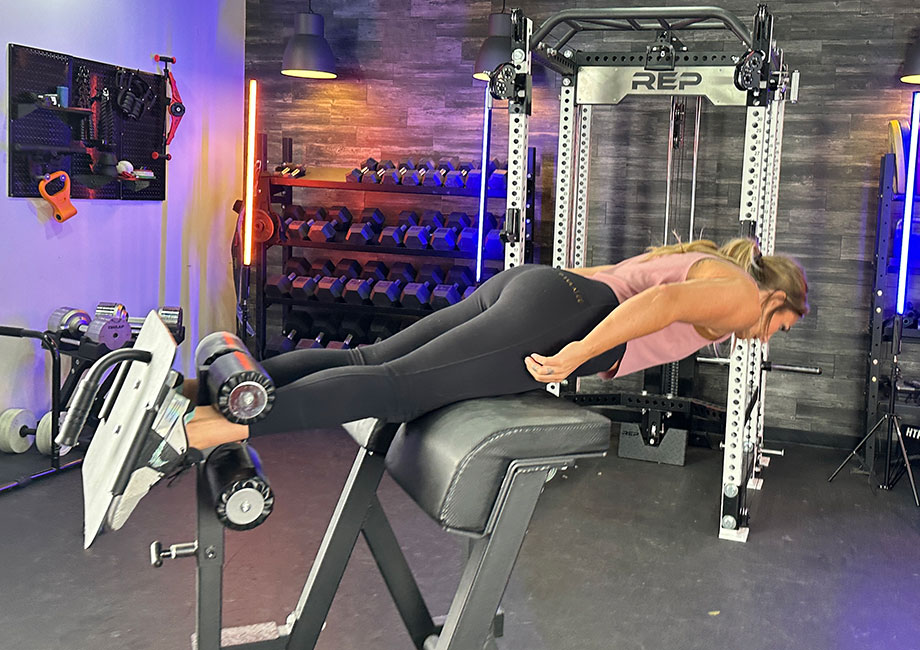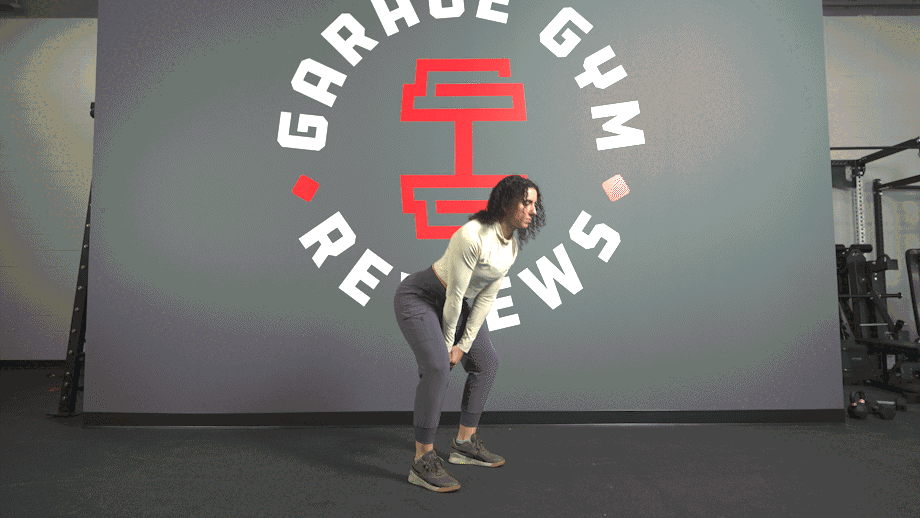When you first set eyes on the glute hamstring developer (GHD for short), it may look like some medieval torture device. It may be torture but only for your hamstrings. Kidding; well, just a little. The Glute Ham Raise exercise, or GHR exercise for short, is only available in some gyms, but when it is, it’s the recommendation of this certified personal trainer that you should definitely take advantage of this wonderful piece of equipment.
RELATED: 9 Strength-Building Hamstring Exercises At Home
Although leg exercises like leg curls and Romanian deadlift variations are great for the posterior chain, the GHR focuses on the eccentric contraction of the hamstrings, where the strength gains happen. Strengthening your glutes and hamstrings eccentrically is fantastic for adding some juice to your caboose but also preventing the dreaded muscle strain of all time, the hamstring strain.
If you’ve ever experienced a hamstring strain, you should do everything possible to prevent it from happening again. For this reason, the GHR exercise must be regular exercise in your hamstring routine.
RELATED: Lower-Body Workouts
Ready to bulletproof your lower body and build some booty? Then let’s go!
How to Do the GHR Exercise
- Adjust the GHD so your feet are secure behind the pad and you can press back against the backboard.
- Ensure your quads are resting on the middle of the pad and your knees are just below it.
- Bend your knees at a 90-degree angle, squeeze your glutes, and get your shoulders down, chest up, and arms folded across your body.
- Then push your toes and feet into the pad and backboard and extend the knees.
- Slowly lower your torso until you are horizontal to the floor.
- Pull back to the starting position by contracting your glutes and hamstrings.
- Reset and repeat for desired repetitions.

GHR Exercise: Muscles Worked
The muscles the GHR works are given away in the title, but there are a few more it trains. Here are the primary muscles that benefit from this excellent posterior chain exercise.
- Erector Spinae: Or lower back if you don’t want to get too fancy. These three muscles keep the spine neutral so the larger muscles can do their job.
- Hamstrings: Many hamstring exercises train knee flexion or hip extension, but lucky for you, the GHR trains both hard and heavy.
- Glutes: The GHR covers all three muscles’ contraction for the glutes. They are engaged isometrically to keep your spine neutral. Eccentrically, you lower your torso. Concentrically you extend your hips to pull back to the starting position.
- Gastrocnemius: This calf muscle crosses the knee and ankle joint, so it helps with knee flexion, and plantar flexes the foot to ensure the larger muscles are engaged correctly.
Trainer Tips for Proper Form
The GHR is an intense activation exercise for your glutes and hamstring and is a challenge with body weight. Because of this, you need to pay attention to the following certified personal trainer (CPT) tips.
Watch Your Knees
Ensure your thighs are secured against the pad and your knees are just off the pad. Having your knees on the pad is okay, but it may lessen the range of motion and aggravate already sore joints.
Make Your Starting Position Rock Solid
The GHR exercise requires a neutral spine to be effective, so rounding the lower back isn’t going to help your case. Keeping your glutes tight, shoulders down, and chest up the entire set will ensure proper form.
RELATED: Lower Back Exercises for Stability and Strength
Secure Your Feet
Placing your feet securely behind the pads near the back plate is essential because, during the concentric contraction, you must push your feet back to raise your torso.

Avoid Breaking At The Hips
When you’re in the bottom position parallel to the ground, there is a tendency for the hip to move first or move backward before anything else moves. Prevent this by locking in your glutes before you raise back up so the hamstrings can work to flex the knee and extend the hips.
GHR Benefits
The apparent reason to do most strength exercises like the GHR is for building muscle and improving strength; you’ll do that with abundance here. But there are other vital benefits to performing this exercise which are listed below.
RELATED: Build Muscle With This Trainer-Made Bodyweight Leg Workout
Lower Risk Of Hamstring Strains
Hamstrings don’t strain when you extend them but flex them. The GHR hones in on the eccentric contraction, and increasing the strength with this contraction has been shown to lower the risk of hamstrings strains1.
Lower-Back Friendly
Many great exercises for the glutes and hamstring involve the barbell. Powerlifting exercises like the barbell back squat, deadlift, and good morning variations load the spine . This is neither bad nor good, but if you’re suffering from low back pain, you can hit them hard with the GHR exercise without stress on your lower back.
Helps You Run Faster
Strengthening the hamstrings with the GHR exercise will help you run faster by improving your coordination, power, and VO2 max2. And it improves your sprinting efficiency through better movement coordination3.
Better Posture
Your upper back position is essential and gets most of the love regarding posture. But the length and strength of your lower back, glutes, and hamstrings, which support your torso, also play an important role in standing posture.
RELATED: Best Rhomboid Exercises for Upper Back Strength
GHR Alternatives
If you don’t have access to a GHD and still want to strengthen the glutes and hamstrings, here are a few GHR alternatives.
Barbell Good Morning
Why do it: The good morning exercise trains the same muscle groups as the GHR exercise, emphasizing your lower back.
How to do it:
- Set up a barbell in the squat rack at the height you use for squats.
- Get under the barbell, unrack it, and position yourself with your shoulders down, chest up, and feet hip-width apart.
- Walk backward a few steps, and with a slight bend in your knees, hinge until your upper body is almost parallel to the floor.
- Reverse to the starting position by contracting your glutes and hamstrings.
- Reset and repeat for desired reps.

Barbell Hip Thrusts
Why do it: Although it doesn’t train the hamstring like the GHR exercise, the barbell hip thrust workout allows you to load the glutes heavily for hypertrophy gains.
How to do it:
- Sit on the ground with your back up against a weight bench.
- With padding across your pelvis, roll the barbell into a comfortable place.
- Secure the barbell and perform a hip extension to get into position.
- Your shoulder blades should be on the bench, and your upper body and hips should be in a straight line.
- Keep your upper body locked in, lower your glutes to the floor, and perform a hip extension until lockout.
- Reset and repeat for desired reps.
RELATED: Resistance Band Exercises for Glutes

Romanian Deadlifts
Why do it: Like the GHR exercise, the RDL provides constant tension on the glutes and hamstrings, only with more load.
How to do it:
- Set up a barbell in the squat rack at around hip height.
- With your feet hip-distance apart, grip the loaded barbell with an overhand grip and take a few steps back.
- Then with the barbell in front of your thighs, lower your shoulders down and lift your chest.
- Take a breath and perform a hip hinge until the barbell is below your knees.
- Contract your glutes to reverse back to the starting position.
- Reset and repeat.

Kettlebell Swings
Why do it: Kettlebell swings train the glutes and hamstrings for strength, power, and muscular endurance.
How to do it:
- Stand with your feet wider than shoulder-width apart, with one KB in front of you.
- Hinge down to grip the kettlebell, squeeze your armpits, and get your chest up.
- Hike the kettlebell behind you like an NFL snapper, then thrust your hips forward to around chest height.
- Finish the swing by squeezing your glutes and quads.
- Repeat for reps.
RELATED: Best Kettlebells

GHR Exercise: FAQs
What does GHR stand for in exercise?
GHR is short for glute and hamstring raise; for this exercise, you’ll need a specialized piece of equipment called a GHD or glute ham developer.
What is the difference between GHR and back extension?
There are differences in the equipment used and the setup involved, but the most significant difference is that the back extension has a lower back emphasis. At the same time, the GHR focuses more on the hamstrings and less on the lower back.
RELATED: How to Do Back Extensions At Home
What is the GHD exercise called?
GHD is short for glute ham developer, and the exercise that it’s primarily designed for is called the glute hamstring raise, or GHR exercise for short.
References
- Bourne MN, Timmins RG, Opar DA, Pizzari T, Ruddy JD, Sims C, Williams MD, Shield AJ. An Evidence-Based Framework for Strengthening Exercises to Prevent Hamstring Injury. Sports Med. 2018 Feb;48(2):251-267. doi: 10.1007/s40279-017-0796-x. PMID: 29116573.
- Chtara M, et al. Effects of intra-session concurrent endurance and strength training sequence on aerobic performance and capacity. Br J Sports Med. 2005 Aug; 39(8): 555–560.
- Prince C, Morin JB, Mendiguchia J, Lahti J, Guex K, Edouard P, Samozino P. Sprint Specificity of Isolated Hamstring-Strengthening Exercises in Terms of Muscle Activity and Force Production. Front Sports Act Living. 2021 Jan 21;2:609636. doi: 10.3389/fspor.2020.609636. PMID: 33554110; PMCID: PMC7859261.







